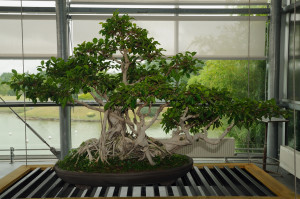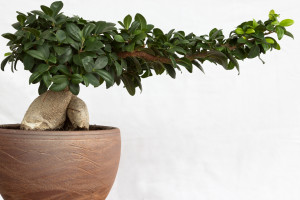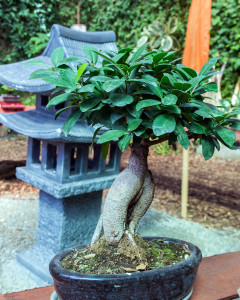Bonsai ginseng is an important part of the bonsai culture, one of the most famous Japanese arts, and it symbolizes one of the best-known Asian traditions.
Bonsai art appeared over a millennium ago in the Chinese Empire,and at the time it was known as penzai. It was  soon adapted and redefined by the Japanese and then spread all over the South-East Asian regions.
soon adapted and redefined by the Japanese and then spread all over the South-East Asian regions.
Translated literally as tree in a tray, the bonsai culture includes different species of miniature trees.
Bonsai Ginseng-Ficus Retusa
Ginseng bonsai also known as ficus retusa, Banyan fig or ficus ginseng,is one of the most famous bonsai trees, not only because it is easy to care, but also due to its beautiful appearance.
Although ginseng is a plant with long tradition in the Asian cultures, ginseng bonsai appeared around 250 years ago in Taiwan and Malaysia when ficus ginseng was discovered. Ginseng bonsai, together will all the other bonsai species, spread rapidly through all Asia, became popular in North America and then all over the world.
Bonsai Harmony
Bonsai art, and ginseng bonsai implicitly, is representative for the Japanese people’s way of thinking and their view about the world. It is not only a horticultural practice, but it also inspires harmony, equability and simplicity.
- All these aspects are recreated differently by every bonsai artist, especially because the age as an aesthetic aspect is also transmitted through the created bonsai.
- Therefore the concept of age is highly developed during the creation of a bonsai, because a tree can depict very well different ages if it is carefully grown. The equability in a bonsai reflects stability and strength.
- Also, its aspect depends largely on the part of the world where it is grown: in the Western areas, bonsai trees are created to incorporate a perfect symmetry, while a designed imperfection is extremely appreciated in the Asian countries.
- Simplicity characterizes the Japanese culture and this concept can also be seen in art, architecture or home design. This way, the beauty and simplicity of the nature is brought into the house through an ornamental miniature tree.
- The Japanese culture also inspires a harmony tendency in any creation and in bonsai art more than in anything. Therefore, the harmonious elements considered in the creation of a bonsai tree are the shapes and textures which make the bonsai corner a place of miniature nature.
Bonsai Concepts Reflected by Ficus Ginseng
Ginseng bonsai is an  excellent tree that encloses all these essential elements of bonsai art. Its strong root and trunk along with its oval green leaves can symbolize the simplicity and harmony of the nature.
excellent tree that encloses all these essential elements of bonsai art. Its strong root and trunk along with its oval green leaves can symbolize the simplicity and harmony of the nature.
The different species of ginseng ficus come with various simple ways of wiring, pruning and transplanting the tree. In this way, it easy for you to grow a bonsai ginseng and create a beautiful, harmonious and balanced focal point in every room.
In creating this natural peacefulness, the pot in which the ginseng bonsai grows should be taken into consideration very carefully. In order to respect the unity and shades of the nature, the pot of a ginseng bonsai must be in accordance with the color of its leaves and the size of the bonsai.
Bonsai Ginseng– Specific Characteristics
Bonsai ginseng describes that kind of bonsai for which the ficus ginseng or banyan plant is used. It is a highly appreciated bonsai tree both for its great looks and low maintenance. You can grow it indoors, because it does not necessarily require direct sunlight, but also outdoors where the light of the sun will make it stronger and healthier.
Ginseng bonsai do not require intensive care. Since its care techniques are relatively simple, the feeding, repotting, wiring and pruning of a bonsai ginseng can be done by anyone. For this reason, it is considered the perfect tree for bonsai beginners.
You can start seeding out a ginseng bonsai right away, but keep in mind that it will only become a veritable bonsai when it is pruned and it gains the shape you desire.
This leafy tree has interesting roots that allow you to create two different bonsai styles: with the roots over a rock or exposed roots. Bonsai ginseng roots take various shapes while growing, its ramifications becoming large and strong when reaching maturity.
Bonsai Ficus Ginseng
This type of bonsai combines all the aspects of a bonsai, from the artistic implications and essential elements to the easy care and beautiful appearance given by its leafy top and complex root system.
A ficus ginseng will add an atmosphere calm and harmony within your home, and a wonderful and inspiring present for your loved ones.




